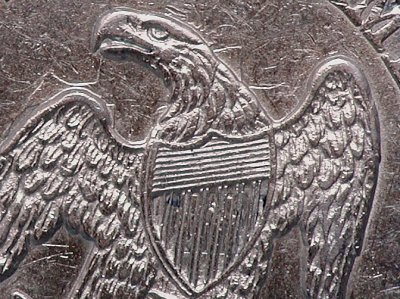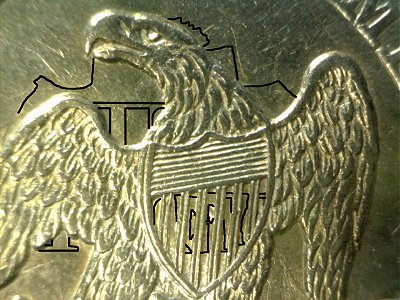

|
|
|
1857 Liberty Seated Quarter Dollar - Flying Eagle Cent Clashed Reverse
by Greg Johnson
Variety collectors, like collectors in general,
seem to have favorite issues that really excite them and others that just don’t
“flip their switch”. An informal, and decidedly unscientific, opinion
poll suggests that the 1857 quarter with Flying Eagle Cent clash has a kind
of love it or hate it following. The proponents find it cool that two dies from
different denominations were clashed together. Those that do not find the variety
appealing most often note that it is hard to attribute and “not a naked
eye variety.”
Personally, I tend to think of the 1857 with Flying Eagle Cent clash as a misunderstood
variety. First, like any coin issue, not all examples are created equal. But,
in addition to strike, technical grade, surfaces, luster and eye appeal, the
strength of the clash also varies between examples. Apparently due to striking
pressure, and/or die wear after the clash, even coins with similar strike characteristics
and grade can have clash marks with notably different definition. Examples in
lower grade (VF and below), with weak clash marks, or with too much embedded
dirt and crust can be quite difficult to attribute.
However, examples in high grade, with strong clash marks, or with clean surfaces
are attributable with the naked eye if the collector knows what to look for
and how to look for it. A coin in hand, rotated under an appropriate light source,
will show distinctive clash marks above and below the eagle’s left wing
and just to the right of the eagle’s neck. The key is the light source
and rotating the coin under that light source in just the way it should be done
to check for surface hairlines.


Photography is another matter entirely. Attempting
to capture the clash marks in a photograph or detect them in an EBay listing
can be beyond challenging. The photograph for this column became such an exercise
that it was necessary to enhance the clash marks with lines drawn in Photoshop
(as seen below). That which can be seen so easily with binocular vision and
movement under a light source can be maddeningly difficult to capture with a
single, stationary lens and fixed light source.
The most recent (and soon-to-be-published) quarter variety survey showed 15
examples in LSCC member’s hands; 7 in VF, 5 in XF and 3 in AU. Both NGC
and PCGS have one mint state example certified, with the finest known a PCGS
MS64. The variety seems to be popular, rather expensive when attributed, and
elusive with a rarity estimate of R5 (31 to 75 known) in all grades.